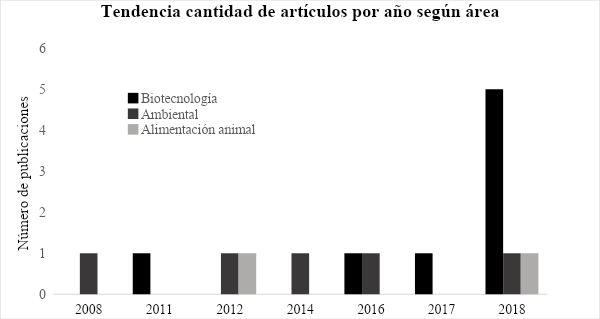Technological advances in liquid watershed management from food production centers
DOI:
https://doi.org/10.33131/24222208.339Keywords:
food industry, liquid waste, liquid waste managementAbstract
In this review, a search, analysis and collection of information, of a scientific, technological and commercial nature, is made on the issue of liquid discharges in food industries. Relevant keywords and restrictions were defined, about 40 scientific articles and 20 patents that met the search criteria were reviewed. The results indicate that the most used process for the treatment of liquid waste is through its dehydration and treatment in wastewater plants, however, due to its composition, it is important to implement circular economy, and use these by-products as raw material for the production of syrups with high sugar content, production of alcohols, enzymes, biopolymers, among others. The Scientometric analysis indicates that Spain and the United States are pioneers in research and patents on the subject respectively, while Colombia does not present publications in the analyzed time interval.
Downloads
References
MINISTRY OF ENVIRONMENT AND WATER, “NATIONAL WASTE MANAGEMENT PLAN 2014-2020,” Sofia, Bulgaria, 2014.
J. Gustavsson, C. Cederberg, U. Sonesson, R. Van Otterdijk, A. Meybeck, and F. Rome, “FAO - News Article: Cutting food waste to feed the world,” 2011.
F. M. Castro Aravena, “Estudio de los residuos industriales líquidos y evaluación de las alternativas de mejora en la industria cervecera Valdivia,” Universidad Austral de Chile, 2003.
European Commission European, “PREPARATORY STUDY ON FOOD WASTE ACROSS EU 27,” 2010.
Food processing industry news, “What a waste of potatoes,” 2015. [Online]. Available: https://www.foodprocessing.com.au/content/sustainability/news/what-a-waste-of-potatoes-445666004. [Accessed: 07-Dec-2019].
R. Devesa-Rey, X. Vecino, J. L. Varela-Alende, M. T. Barral, J. M. Cruz, and A. B. Moldes, “Valorization of winery waste vs. the costs of not recycling,” Waste Manag., vol. 31, no. 11, pp. 2327–2335, Nov. 2011.
Y. Zhang, X. C. Wang, Z. Cheng, Y. Li, and J. Tang, “Effect of fermentation liquid from food waste as a carbon source for enhancing denitrification in wastewater treatment,” Chemosphere, vol. 144, pp. 689–696, Feb. 2016.
D. M. Gómez Quintero and A. I. González Alcalá, “II Guía práctica Innovitech: vigilancia tecnológica para la innovación,” Servicio Nacional de Aprendizaje (SENA), 2016.
(FAO) Food wastage footprint, “Food Wastage Footprint - Impacts on Natural Resources – Summary report,” 2013.
(FAO) Food wastage footprint, “Global Food Losses and Food Waste: Extent, Causes and Prevention - World | ReliefWeb,” 2011.
T. H. Kwan, K. L. Ong, M. A. Haque, W. H. Kwan, S. Kulkarni, and C. S. K. Lin, “Valorisation of food and beverage waste via saccharification for sugars recovery,” Bioresour. Technol., vol. 255, pp. 67–75, May 2018.
S. Hegde, J. S. Lodge, and T. A. Trabold, “Characteristics of food processing wastes and their use in sustainable alcohol production,” Renewable and Sustainable Energy Reviews, vol. 81. Elsevier Ltd, pp. 510–523, 2018.
R. Ravindran and A. K. Jaiswal, “Exploitation of Food Industry Waste for High-Value Products,” Trends in Biotechnology, vol. 34, no. 1. Elsevier Ltd, pp. 58–69, 01-Jan-2016.
M. Esteban-Gutiérrez, J. Garcia-Aguirre, I. Irizar, and E. Aymerich, “From sewage sludge and agri-food waste to VFA: Individual acid production potential and up-scaling,” Waste Manag., vol. 77, pp. 203–212, Jul. 2018.
A. Monteiro et al., “Liquid by-products from fish canning industry as sustainable sources of ω3 lipids,” J. Environ. Manage., vol. 219, pp. 9–17, Aug. 2018.
M. G. Cruz et al., “Waste mitigation: From an effluent of apple juice concentrate industry to a valuable ingredient for food and feed applications,” J. Clean. Prod., vol. 193, pp. 652–660, Aug. 2018.
O. Guneser, A. Demirkol, Y. Karagul Yuceer, O. Togay, I. Hosoglu, and M. Elibol, “Biotechnology and Industrial Microbiology Production of flavor compounds from olive mill waste by Rhizopus oryzae and Candida tropicalis,” Brazilian J. Microbiol., vol. 48, pp. 275–285, 2017.
C. Du et al., “Valorization of food waste into biofertiliser and its field application,” J. Clean. Prod., vol. 187, pp. 273–284, Jun. 2018.
P. Zhang, C. J. Lin, J. Liu, P. Pongprueksa, S. A. Evers, and P. Hart, “Biogas production from brown grease using a pilot-scale high-rate anaerobic digester,” Renew. Energy, vol. 68, pp. 304–313, Aug. 2014.
L. Guerrero Saldes and D. Alkalay Lowitt, “TRATAMIENTO DE RESIDUOS LÍQUIDOS DE UNA FÁBRICA DE GALLETAS.”
I. S. Arvanitoyannis, Waste Management for the Food Industries, 16th ed. Elsevier Inc., 2008.
K. Rezzadori, S. Benedetti, and E. R. Amante, “Proposals for the residues recovery: Orange waste as raw material for new products,” Food and Bioproducts Processing, vol. 90, no. 4. pp. 606–614, Oct-2012.
D. Klein-Marcuschamer, P. Oleskowicz-Popiel, B. A. Simmons, and H. W. Blanch, “The challenge of enzyme cost in the production of lignocellulosic biofuels,” Biotechnol. Bioeng., vol. 109, no. 4, pp. 1083–1087, Apr. 2012.
E. C. G. Aguieiras, E. D. Cavalcanti-Oliveira, and D. M. G. Freire, “Current status and new developments of biodiesel production using fungal lipases,” Fuel, vol. 159, pp. xiii–xv, 2015.
E. Mejía, L. Osorno, and J. Ospina, “Microorganismos Hierro–Azufre Oxidantes Una Alternativa Biotecnológica,” Rev. CINTEX, vol. 19, pp. 63–77, 2014
G. D. Jojoa-Unigarro, H. L. Rodríguez-Zambrano, and S. A. Cardona-Gallo, “Tratamiento de aguas residuales textiles a partir de métodos biológicos,” Rev. CINTEX, vol. 20, no. 1, pp. 11–34, jun. 2015.
S. Gabarrón, M. Dalmau, H. Monclús, J. Comas, and I. Rodriguez-Roda, “Design and operational issues of 7 full-scale MBRs for municipal wastewater treatment,” Rev. CINTEX, vol. 20, no. 1, pp. 35–51, 2015.
R. H. YOUNG and R. A. LAWRIE, “Utilization of edible protein from meat industry by-products and waste,” Int. J. Food Sci. Technol., vol. 9, no. 2, pp. 171–177, Jun. 2007.
Z. C. Y. Chuan, H. Chengguo, T. Yilei, C. Hongyang, G. Zheng, Z. Heliu, Z. Bo, W. Wei, L. Pengfei, J. Fan, Z. Xiaonan, X. Yang, Y. Guohua, “RU2531931C1 - Method of physical and chemical wastewater treatment - Google Patents,” 2014.
M. A. Molina Ranaval, “SISTEMA DE TRATAMIENTO DE RESIDUOS LÍQUIDOS MODULAR MÓVIL CAMPO DE LA INVENCIÓN,” 2016.
Z. X. J. Lina, “CN203582529U - Evaporation crystallization system for processing saline organic wastewater/liquid waste - Google Patents,” 2013.
Q. Pansheng, “CN203159266U - Integrated liquid waste and sludge treatment device - Google Patents,” 2013.
S. R. Temple and H. Everett, “WO2015137966A1 - Methods for treating liquid streams containing quaternary ammonium compounds - Google Patents,” 2014.
S. Viktorija Nikolaevna, “RU02320547 WASTEWATER TREATMENT PROCESS,” 2008.
T. Pinia, “US20160083309A1 - System, method, and composition for enhancing solutions from bioreactors for processes including liquid fertilizer preparation and nutrient extraction - Google Patents,” 2016.
U. V. Z. Vasilyeva, Y. Barasheya, “RU2531931C1: Method of physical and chemical wastewater treatment,” 2013.
J. L. Palacio, M. Rincón Fulla, and I. Rivera, “Modelo Físico-Matemático para la Estimación del Tamaño de Partículas en Suspensiones Coloidales de Baja Dilución,” Rev. CINTEX, vol. 20, no. 1, pp. 53–68, 2015.
A. Papadaki et al., “Production of wax esters via microbial oil synthesis from food industry waste and by-product streams,” Bioresour. Technol., vol. 245, pp. 274–282, 2017

Downloads
Published
How to Cite
Issue
Section











